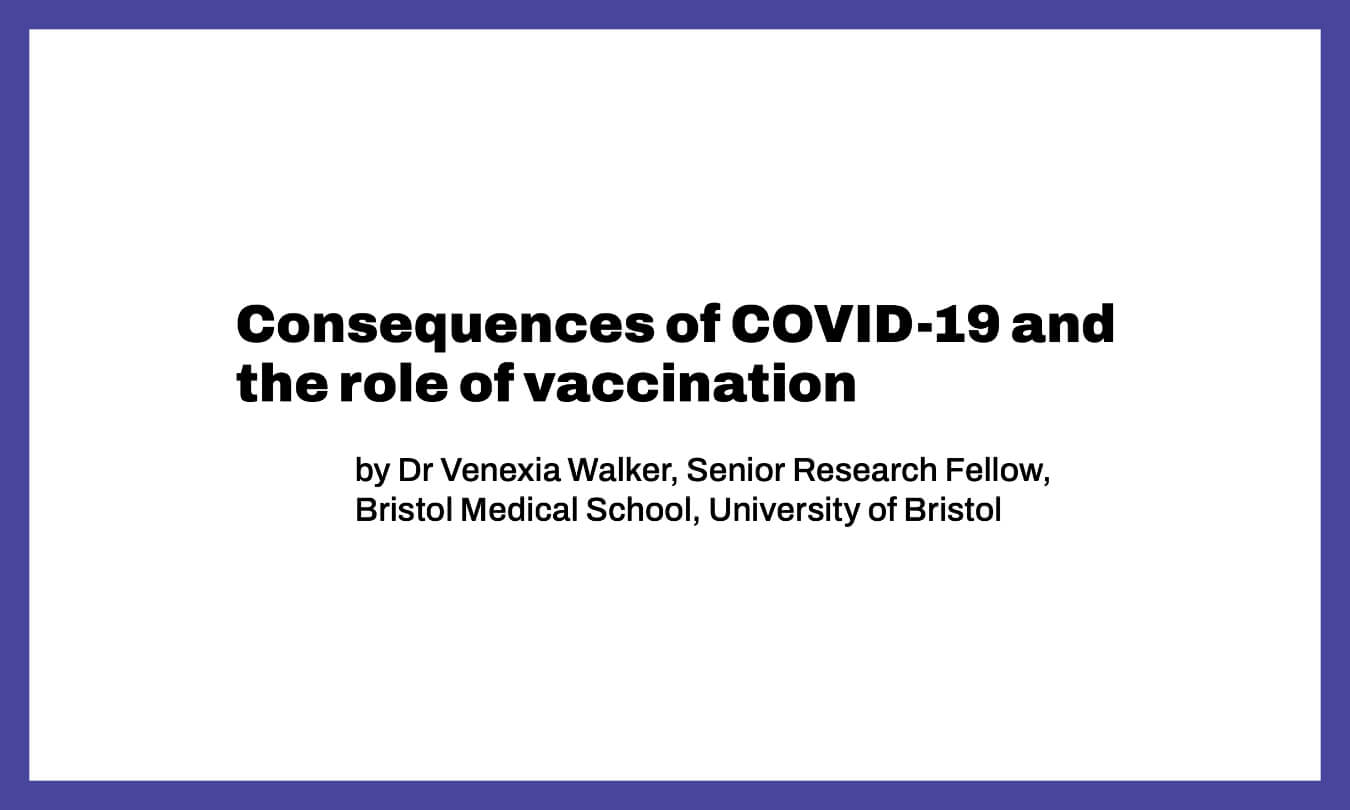Consequences of COVID-19 and the role of vaccination
- Posted:
- Written by:
-
- Venexia Walker
- Categories:

This article is part of a series: The Past, Present and Future of OpenSAFELY
- The past, present and future of OpenSAFELY: Introduction
- How OpenSAFELY works
- Co-pilots give newcomers a helping hand
- Standard tools for data preparation, and federated analytics
- Output checking helps to keep private data safe
- The legal basis: ethics, controls and building trust
- Earning and maintaining trust: PPIE and more
- How OpenSAFELY began
- Consequences of COVID-19 and the role of vaccination
- “No other platform comes close”
- The 'unreal' speed of OpenSAFELY
- Using OpenSAFELY to fight antimicrobial resistance
- OpenSAFELY and antibiotics
- Using OpenSAFELY to carry out a randomised trial
- The OpenSAFELY Collaborative
- Some reflections about funding
- What's next for OpenSAFELY?
Written by Dr Venexia Walker, Senior Research Fellow, Bristol Medical School, University of Bristol
On 11 February 2020, the disease associated with SARS-CoV-2 was named by the World Health Organisation as COVID-19. Over time, SARS-CoV-2 strains have mutated, resulting in new variants. Different strains differ in their infectiousness, symptom profiles, and potentially their consequences, so each warrants detailed study.
The rapid rollout of COVID-19 vaccination was a crucial component of the public health response to the pandemic. Rollout began on 8 December 2020, initially aimed at workers in care homes and people over 80 years old. From there, it gradually expanded to cover more people, new vaccines were authorised, and there were several rounds of booster shots.
Right from the start of the pandemic, we knew it was important to identify the consequences of COVID-19 for physical and mental health, and, once vaccines were available, to better understand vaccine coverage (i.e., who received vaccines) and effectiveness (i.e., how well were people protected from the virus). We knew OpenSAFELY was a good place to answer these questions, as the OpenSAFELY-TPP database allowed us to analyse the full primary care records of 45% of the English population with relevant linkages, while the platform enabled cross-institution team science – the likes of which we could not achieve pre-pandemic.
Ours was a large cross-institution team, mainly at the Universities of Bristol and Cambridge. Previously, it would have been very difficult for all of us to work on the same electronic health record dataset, because permissions are usually institution-based. You typically have to arrange honorary contracts, and sometimes even travel to another institution that you want to collaborate with. OpenSAFELY changes all that.
We wanted to find answers to questions such as:
- Are people getting the benefits of vaccination observed in trials?
- How long do the benefits of vaccination last?
- Do the consequences of COVID-19 differ if you are vaccinated when you get it?
Over the years that followed, we published several papers on these and other topics. Some of our findings included:
- The effectiveness of both the Pfizer and AstraZeneca vaccines against infection waned to almost nothing after six months – although they were still very effective against the severe outcomes of hospitalisation or death.
- COVID-19 booster vaccination, compared with no booster vaccination, provided substantial protection against COVID-19 hospitalisation and death, but only limited protection against testing positive for SARS-CoV-2.
Using OpenSAFELY influenced and encouraged good working practices within our team. We made our protocols (documents setting out the plans for research before it happens) more detailed, we implemented code review, and some of our team became qualified output checkers – which provided a greater understanding of what ‘good outputs’ look like.
OpenSAFELY’s built-in reproducibility was a very important factor: code from our early projects became the starting point for later projects, and some of our frequently used code was developed into a reusable action. (In OpenSAFELY, an action is a piece of code written for one study, that can be reused in other studies without copying-and-pasting between them). The ability to reuse code in this way sped up the whole process, which was extremely useful when the pressure of the pandemic on the health service – and on health researchers – was at its height.


